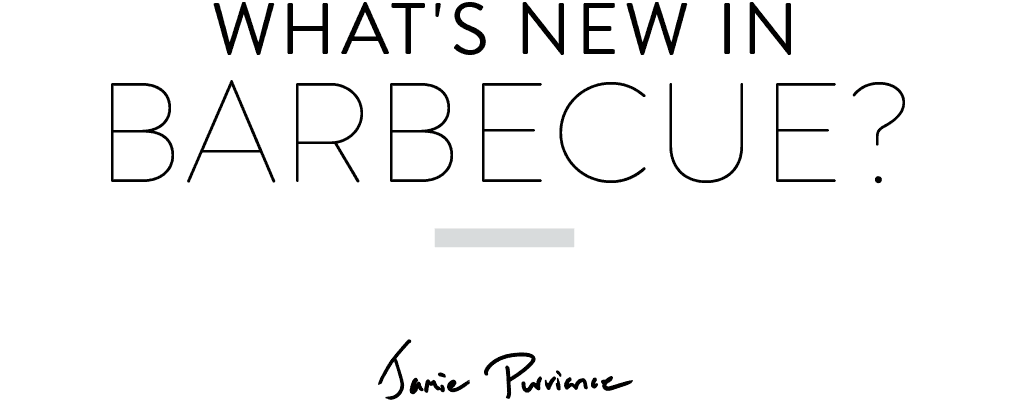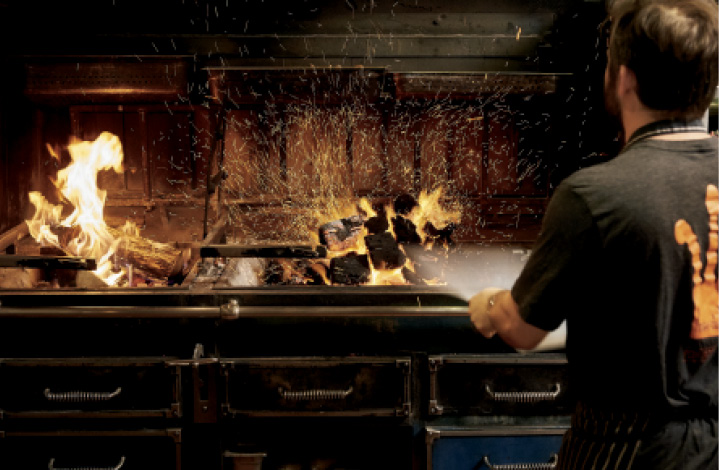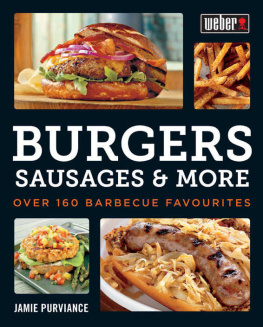


CONTENTS

SPECIAL FEATURES



Whats New in Barbecue
Jamie Purviance

What was once a style of food rooted in the rural South is now almost everywhere, even in big cities, and, in turn, those cities are influencing the food.
B arbecue. Surely youve heard of it, but what exactly is it? I used to think I knew. It was supposed to be spice-rubbed pork ribs glistening with sauce, or tender slices of smoked brisket dripping juices on butcher paper, or succulent shreds of pork shoulder piled high on soft white buns. Those were supposed to be the epitome of barbecuean American institution that has held tightly to strict principles since the first days of our nation.
At least that is what I thought. Several years ago I accidently offended a fellow student at the Culinary Institute of America by inviting him to a weekend barbecue where I intended to grill hamburgers and sausages. He was raised in North Carolina with more than a little local pride, and so he responded indignantly, Thats not barbecue. Real barbecue is cooked in a pit with wood, not on a grill. Then he schooled me about serious regional differences in barbecue. Maybe you have heard of these. In the Piedmont of North Carolina, barbecue means pit-cooked and chopped pork served in a tomato-tinged vinegar sauce with slaw and hush puppies on the side. No beef is allowed. But in Texas proper, barbecue is beefespecially brisket and hefty beef ribsand pit masters there are likely to protest at anyone coating it with sauce or trying to eat it with a fork. On and on my classmate went, pounding his fists on the table and telling me you cant possibly cook barbecue with gas. You have to do it like third-generation pit master Sam Jones at Skylight Inn BBQ in Ayden, North Carolina, where a billboard outside the legendary restaurant clearly states, If its not cooked with wood its not BBQ.
Well, okay, I assumed my red-faced classmate had sufficient credentials that I should believe him. I filed away his lesson about what authentic barbecue means, and for years I tended to agree with it. While writing this book, however, I felt compelled to check his facts and to dig a little deeper. Among other things, I wanted to know about the origins of American barbecue. It turns out that American barbecues starting point was barbacoa, which dates to the 1500s: a framework of green branches and sticks elevated high over a fire for cooking. Thats how barbecue was practiced in a region that is now the West Indies and along the southeastern coast of North America, including Florida. Just to be clear, those Indians were not cooking racks of baby back ribs or smoky briskets to be sliced for barbecue sandwiches. No, no, no. They were cooking fish, turtles, iguana, alligator, and snakespretty much anything they could catch and slaughter. So if you really want to talk about authentic American barbecue, maybe we should forget the pulled pork sandwiches and think instead about how to roast an alligator over a campfire.

In fact, maybe we should forget the whole question of whats authentic. Clearly, with barbecue, the food evolves over time with cultural changes. Today, brisket seems like it is permanently enshrined along with beef ribs and sausage as part of the holy trinity of Texas barbecue meats. Historically speaking, however, brisket is a relatively new thing, and soon it might be replaced (check out the ). What was once a style of food rooted in the rural South is now almost everywhere, even in big cities, and, in turn, those cities are influencing the food. At Hometown Bar-B-Que in Brooklyn, New York, pit master Bill Durney is a lot more creative than he ever would be in Central Texas where he did his barbecue training. On Durneys menu you will find sweet Korean sticky ribs, a Vietnamese-style lamb belly banh mi sandwich with crunchy daikon, and spicy jerk baby back ribs. Why? The people in Brooklyn, some of them from Korean, Vietnamese, and Caribbean backgrounds, like their distinctive international flavors in their barbecue.

Barbecue competitions, including the ones on reality television shows, have made barbecue a sport that has launched winners toward fame and fortune. Lee Ann Whippen was a blue-collar caterer from Virginia who smoked her way to the top at some major competitions. When a restaurateur from Chicago saw an opportunity to take barbecue upmarket, he recruited Whippen to be the executive chef at Chicago q, a fine-dining restaurant in the citys Gold Coast neighborhood. In a space that looks more like a private country club than an old-school barbecue joint, Whippen is wowing diners with her competition-style ribs, blackened alligator, and a brunch menu with eggs Benedict on prime-grade brisket. Brunch at a barbecue restaurant? Yes! Why not?
Doug Adams grew up near Texas barbecue country and took the food for granted until he moved to Portland, Oregon, to attend cooking school. Today this Top Chef finalist cooks at the high-end Imperial restaurant, where his menu draws from a wood-burning grill and tastes from his childhood. Adams food caters to Portlands funky eclectic culture, but still he shows traces of barbecue everywhere. I am obsessed with smoke, he says. I try every piece of meat or produce that comes into the kitchen on the wood grill before it goes anywhere else. At first glance his dish of green beans with smoked elk tongue, kimchi, and a deep-fried egg seems to have no traditional roots at all. Yeah, I know that dish sounds weird, admits Adams, but to me it is so Texas. It is smoked meat and pickles. As for the egg, we deep-fry almost everything in Texas. If you break down my food, you see a lot of barbecue. As a chef I am always asking myself how can I build on barbecue but do it differently.


Traditionalists dont need to worry about these changes. Just because someone like Doug Adams or me or you asks what if? or why not? we are not threatening barbecue; we are broadening it. Gradual change has been part of its nature since the days of barbacoa. In our food-obsessed, Internet-connected, melting-pot nation, change is happening faster than ever, and its no coincidence that the popularity of barbecue is surging. My respect for the classic dishes is deep and permanent, and I have shared many of those recipes with you in this book. I have also shared recipes and stories inspired by the classics but freed by the creativity at play today. I hope you cook them and make them your own. Each time we bring our own styles and stories to the experience, we contribute something real to this ever-expanding phenomenon called American barbecue. So get into it. Barbecue like you mean it and ask yourself, Whats next?
Next page























